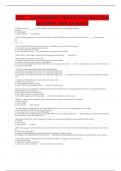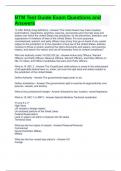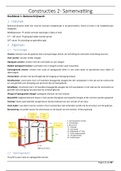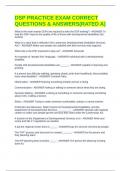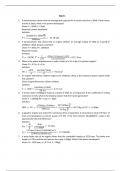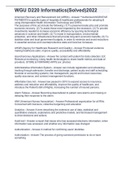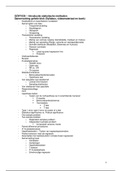Perceptual learning – discrimination between different types Thorndike’s law of effect – Behaviour that is followed by Multistore model of memory: Atkinson &
of stimuli e.g., object/face recognition pleasant consequences is likely to be repeated, and behaviour
Stimulus-response learning – links perceptual and motor followed by unpleasant consequences is likely to be stopped
learning Operant conditioning: B.F. Skinner
Motor learning – modifying motor responses e.g., riding a Positive reinforcement: Positive punishment:
bike/playing tennis Increasing behaviour by adding Decreasing behaviour by adding
a reward a punishing/noxious stimulus
Classical conditioning: Ivan Pavlov
Negative reinforcement: Negative punishment:
US (Food) = UR (Salivation) Increasing behaviour by Decreasing behaviour by Sensory memory:
NS (Bell) + US (Food) = UR (Salivation) removing an unpleasant removing a pleasant stimulus - Iconic (visual), Echoic (auditory), Hapti
CS (Bell) = CR (Salivation) stimulus (smell), Gustatory (taste).
Extinction – CS (Bell) without US (Food) leads to decrease in - Duration typically less than a second
CR (Salivation) Continuous – reinforcement/punishment is given every time Short-term memory:
Spontaneous recovery – after rest, some response might the behaviour occurs - Capacity of 7+/- 2 (Miller, digit span ta
return but not as strongly Partial – reinforcement/punishment only occurs some of the - Duration between 15 and 30 seconds
Generalization – CR to a similar stimuli but not identical time when the behaviour occurs. It also varies over time or - Items can be kept in STM by acoustic
over number of responses. Working memory model: Baddeley and H
Fixed interval – reinforcement only occurs after fixed period, Central executive – the big boss, modalit
regardless of the number of responses e.g., monthly salary capacity, controls subsystems (dysexecuti
Variable interval – reinforcement occurs after randomly Phonological loop – Phonological store (
varying periods of time e.g., checking for messages articulatory control process (speech prod
Fixed ratio – reinforcement occurs after a set number of Visuo-spatial sketchpad – processes and
responses e.g., every 10th time the rat pulls the lever, it spatial information. Visual cache (stores
receives food colour) inner scribe (spatial & movemen
Variable ratio – reinforcement occurs after a random number Episodic buffer – temporary storage for i
of responses e.g., playing on a fruit machine PL and VSSP
Why is this useful? Primary reinforcer – things that directly satisfy a need or Dual task approach – If two tasks use the
- Conditioned taste aversion - an aversion to the taste of a reflexively drive a response e.g., food they cannot be performed as well togeth
foodstuff following the experience of feeling ill after Secondary reinforcer – things that have no intrinsic value but Cue-dependant forgetting – Words learn
consuming it become valued through association with a primary reinforcer environment are recalled better than wo
e.g., money different environment (Godden & Badde
The Hebb rule: Basal ganglia is involved in learning and disease to this area Primacy/recency effect – better recall is
“neurons that fire together wire together” causes deficit to learning automatic or operant responses. given first and last and lower recall in the
There is also the reward circuit that is involved in evaluating Deep semantic encoding promotes best
rewards, this underpins secondary reinforcers. visual encoding results in poor recall
, LECTURE 4: Long-term memory LECTURE 5: Neuropsychology of memory LECTURE 6: Neuropsychology of m
Declarative memory – conscious recollection, sometimes Explicit memory – deliberate attempt to remember a Consolidation – changes in brain activity
called explicit memory previously experienced event (free/cued recall & recognition) permanent structural changes
Non-declarative memory – doesn’t require conscious Implicit memory – revealed when prior exposure to an event Familiarity – context free memory, recog
recollection, sometimes called implicit memory influences behaviour without intention (repetition priming, familiar, likely to remain in amnesic patie
Retrograde amnesia – problems remembering things from perceptual identification, word stem completion) Recollection – context dependent memo
before the event or injury Functional dissociations show that these are separate systems specific details of the event
Anterograde amnesia – problems learning new information Typical recognition involves both mecha
after onset of amnesia (much more common) H.M case study: using the false-fame paradigm
Usually affects learning declarative memories but not non- - Had a bilateral medial temporal lobectomy
declarative. Arises from damage to medial temporal lobe. - IQ remained as did STM and autobiographical memory Ranganath 2004:
- Normal implicit memory but explicit was affected - Hippocampus activity correlates with
Episodic – explicit recollection of things that have happened. - Anterograde amnesia and 3-year retrograde amnesia - Perirhinal activity correlates with fam
Includes familiarity and recollection. (not perfect) Other causes of temporal lobe dysfunction: Support from lesion studies (patient YR a
Semantic – meaning of things/objects/concepts. Temporal lobe epilepsy, Korsakoff’s syndrome, Alzheimer’s,
Superordinate(animal), basic(dog), subordinate(border collie) stroke and head injury Temporal gradient (Ribot’s Law):
Procedural – motor skills, learnt without conscious knowledge Zola-Morgan animal study: There is a time gradient in retrograde am
Perceptual representation system – repeated exposure Induced lesions in Hippocampus, Amygdala, Perirhinal cortex memories are more likely to be lost than
enhances the ability to quickly recognise words/objects and Parahippocampal cortex. They found that all but the memories. Case PZ – 50yrs ago 70%, 40y
amygdala were essential for memory formation 40%, 10yrs ago 0%.
Autobiographical memory – events of your own life, left
hemisphere focused and more about the narrative than Problems with lesion studies: Time limited role for Hippocampus – wh
details - Don’t identify specific processes formed, they use the Hippocampus but o
Flashbulb memories – Vivid memories of the occurrence of - Lesions can disrupt multiple neural systems involvement from the Hippocampus and
specific, surprising, and often shocking public events. Often - Plasticity/reorganization retrieved from the Cortex
not very accurate - Individual variation between brains
Childhood amnesia – very few autobiographical memories Alzheimer’s – better at old memories tha
before the age of three Single dissociation – performance on task A is impaired but Semantic dementia – reversed temporal
Reminiscence bump – many memories between ages 10-30 performance on task B is normal. Deficit is not due to general recent (withing 4 years) than remote eve
impairment. May not be that they involve different processes haven’t been transferred from Hippocam
Eyewitness testimony – accuracy in real-world is approx. 40% but maybe that task B is easier than task B are intact
Own age bias and other race effect can alter this.
Post and pre-event information – Loftus and Palmer (1974) Double dissociation – when a patient is impaired on task A but Encoding – left temporal lobe, frontal lob
speed estimates varied depending on which verb was used performs normally on task B. A different patient performs levels of processing. Left dominance for
when being interviewed, their memory was altered by the way normally on task A but is impaired on task B. This cannot be Retrieval – right temporal lobe, integrate
the question was asked. explained by task difficulty. Better than single dissociation to form an episodic representation
‘Memory is more of a reconstruction than a replay’

